A survival knife is a universal tool in any survival situation: from making a fire to combating a wild beast. It’s rubber handle must be convenient, its stainless steel blade needs proper and timely sharpening, and the price must be bearable. Knives are great weapons and great helpers. To learn all about a survival knife, read the following article.
Firstly, we would like to clarify this thing: there is no such concept as the “best survival knife.” It is simply non-existent; nonetheless, there is such a thing as the “best survival knife for you and your life.” It does not differ much, right? But it turns out that it is of the most importance! Why, would you ask. Because all survivalists are different: there is much difference where it is a hunting knife or a carving knife. Everyone strives for various aims and survival skills that make some survival knives more proper for one than for the masses, not to mention that you can find in retail both amazing and disgusting survival brands despite being good or bad for each individual.
That way, this endurance knife summary aims to present you with the most useful products and data, so one will be self-assured in choosing which tool to buy.
TOP Best 12 Coolest Survival Knives in Retail Today
Since we know what to search for (in general) in a decent survival knife, we should experience some detailed summaries of the GREATEST knives for surviving circumstances.
So, we are all in good times to start our point-by-point reviews that will help you further learn what makes a worthy endurance knife, and you’ll likewise acknowledge best uses for every one of these products.
ESEE Model 4 Knife
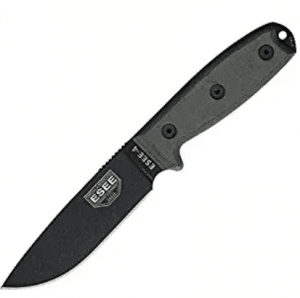
It carries the blade well and can be honed effectively; however, you need to take care to keep it clean and a bit lubricated to prevent staining or rust. The presented sheaths appear to have shifted over the production run, with some of the older models missing the MOLLE connections. Different adaptations had a shaped Kydex cover, which holds the knife safely set up.
The latest form has a basic poly sheath. However, ESEE actually sells the Kydex cover independently and at a rational price.
Advantages:
- Top-notch 1095 steel blade
- Moderate design with not many shortcomings
- The 4-inch blade is perfect for most knife tasks.
- Lifetime guarantee
Disadvantages:
- The blade requires usual upkeep.
- Distinctive sheath designs may or may not incorporate MOLLE attachments.
Morakniv Kansbol Knife

Directly out of its packaging, the Kansbol is dangerously sharp and uncommonly resistant to the rust and erosion that usually harms numerous knives, by the way. Stainless steel is additionally hard, making it harder to ding or dull one’s knife.
The blade’s rear is nearly a 90-degree edge, creating an ideal surface to make sparkles and team on the blade edge. The tough polyamide injection shaped handle and the sheath is easy to grip. Actually, they were created for long-time use and will last forever.
They work really great together, making a tick lock closure that prevents the knife from accidentally dropping out while moving. To be honest, there are 2 sheath alternatives to browse, and differences only matter depending on how you plan to mount the knife.
Advantages:
- Deeply immune to corrosion and such things
- Strong grip and sheath
- It holds an edge pretty well.
- Lightweight despite being big
- Numerous sheath items
Disadvantages:
- Only partial tang
- Pure is difficult to sharpen.
ESEE Model 5 Knife
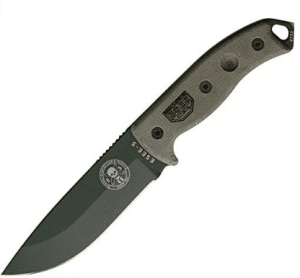
This gives the ESEE 5 a really great time of realistic usability for the most oppressive chopping and batoning tasks.
The micarta grip scales are twisted on with hex-key bolts, enabling you to set (and clean) one’s knife completely. Furthermore, the scales highlight a bow drill divot, intended to provide any person with a strong point to implement pressure downward on the drill shaft when starting a fire. It is an extraordinary detail and far more reliable than striving to look for a rock or shell with a natural divot.
Moreover, the heavy steel blade emphasizes an additional survival part–the pommel is a hardened point for breaking glass!
Advantages:
- Glass breaker on the grip
- Bow drill divot in the handle
- A great carbon steel 1095
- Durable micarta handles and Kydex shell
Disadvantages:
- The length (11 inches) might be cumbersome.
- High carbon steel needs the usual upkeep.
- More weighty thank alike knives
Morakniv Garberg Knife
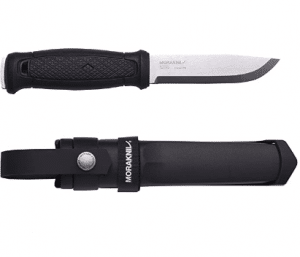
It’s based on the full-tang chunk of 14C28N hardened steel, broadening 9 creeps from the top of the blade to the exposed pommel. This gives it toughness and durability, with fewer parts to break.
The tempered steel comes well sharpened out of the package and will hold that edge for quite a while, without erosion or dulling; moreover, like all stainless steel blade knives, you may think that it’s harder to file at home.
Similar to other Morakniv products, the core of the blade is square-ground to give a decent edge to starting fire starters, which forestalls harm to the sharp edge. The Garberg likewise accompanies one of three options in sheath design, from a classic leather flap sheath to a polymer belt or MOLLE option.
Advantages:
- Excellent hardened steel
- Will prevent erosion
- Different sheath alternatives
- Holds the blade well
Disadvantages:
- Difficult to sharpen
- The grip is bulky, harder to hold in case a person has little hands.
Gerber LMF II Infantry Knife
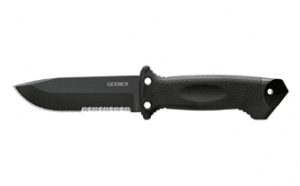
Moreover, every hunter will acknowledge this hunting knife because the construction of the knife itself gives you a well-made cutting blade for slicing and a serrated edge to cut the hardest things (like safety belts and ropes).
The over-molded handle gives a lot of grip, guaranteeing that you don’t lose hold of the knife even in the most extremely terrible conditions. It’s actually moderately huge to hold even while wearing gloves, yet not very massive for exposed bare-handed employment.
The handle includes a sharp tempered steel cap to penetrate through strong glass, but at the same time, it’s detached from the steel of the blade, protecting to prevent electric shock.
In a novel addition, the LMF II has beating holes in the handle, intended to tie it safely to the point of a lance. Ideally, you’ll never require it, yet it gives a choice to a significant distance weapon in hunting or battle, and hunting knives are quite popular, by the way.
Advantages:
- Lash points for use as a lance
- Pleasant handle
Disadvantages:
- Only partial full-tang
- Difficult to file the serrated segment of the blade
ESEE Desert Tan Izula II Knife
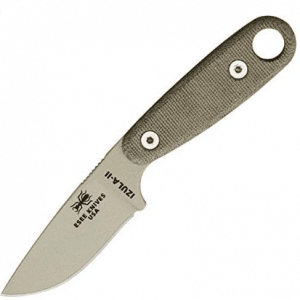
With a 2.625″ cutting side and a general length of just 6.25″, it’s one of the more conservative blades in its group. In any case, that doesn’t mean ESEE holdbacks on the highlights or design.
The Izula-II is based on the full-tang bit of high carbon 1095 steel, an extraordinary decision for a wide range of cutting blades. It takes an edge pretty well and is anything but difficult to grind.
The micarta parts are detachable if you need to wash or fix them – yet it actually implies you can tear the knife down and do a paracord wrap grip if you want that!
Nonetheless, the handle design is one of the main highlights of the Izula-II, making it simple to hold and work with on even the toughest tasks (food prep, cleaning, and so forth). So, I wouldn’t suggest that option except if you truly want to carry an extra paracord on the hand.
Advantages:
- Minimized and simple to hide
- Great 1095 steel sharp blade
- Replaceable hold scales
Disadvantages:
- The sheath lacks a belt clip.
- High carbon steel requires regular upkeep to prevent rusting.
Schrade SCHF52M Frontier Knife
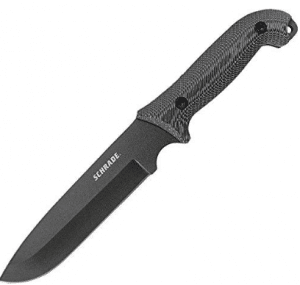
At 13″, generally speaking, and almost 18oz, it has all qualities required for chopping, parting, and hacking at vegetation. Its full-tang characteristic even dares batoning and other high effect tasks!
The micarta scales give a suitable grasp, while a large finger guard shields your hand from shifting onto the blade. A lanyard hole means you can append a paracord circle to clip the point off and keep from dropping the knife.
The polyester belt sheath is useful and holds the blade safely, just as the included Ferro rod firestarter and honing stone. However, it’s not the greatest design. A MOLLE-viable cover would be a decent addition, and there are many these accessible as alternatives.
At last, there have been a few reports of QC problems from the organization. However, returns and guarantee inclusion have been acceptable.
Advantages:
- Greatly build full-tang design.
- Really big
Disadvantages:
- Weighty
- The sheath isn’t the best.
Ka-Bar Becker BK2 Knife
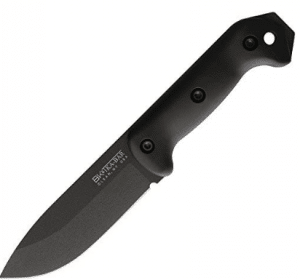
The KA-BAR Becker BK2 Companion is an incredible thing that takes the absolute best key points from both the unbelievable fighting blades and the most needed survival designs.
It is made of 1095 high carbon/vanadium steel and, including the full tang design, is a solidly constructed and durable knife. With a total length of 10.5 inches and more than 5 inches of sharpened side, the Becker BK2 has a ton of blade. However, it tips the scales at just 16 ounces.
The drop point blade design is ideal for small, detailed tasks such as skinning and butchering meat, with a smooth front edge that makes cutting simple. The cool handle is made from Ultramide, a manufactured material that can face a lot of abuse and still be completely fine. However, the creators of the knife could withstand a little more texture to grip.
A strong sheath made of glass-strengthened nylon keeps the blade sharp and protected, in addition to it connects to almost anything with a MOLLE viable plan.
Advantages:
- Lightweight
- Great knife design
- Rock-solid high-carbon 1095 steel
Disadvantages:
- Blade lock-in cover is difficult to withdraw.
- Ultramid scales are smooth when wet.
FallKniven FN78 F1 Knife

At simply over 8″ by and large, it’s a minimized endurance knife without any extras. The 4″ slanted blade is clear and basic, making it simple to hone and keep up. It’s ideal for point-by-point work like cleaning and skinning game; besides, it’s not really huge enough for chopping or batoning processes.
Made of cast steel, with a full-tang design and an exposed pommel, it will certainly work for a long time. The 90-degree grounded rear side makes it easy to strike sparks from the Ferro-rod firestarter. The elastomeric handle is easy to hold in any condition and does not become brittle or tear with age and use.
Like other Fallkniven knives, there are a lot of fakes for this model. As usual, just purchase from reliable vendors and remember to check the knife on appearance. Confusing edge grinds and low quality honing are the most evident signs of a false item.
Advantages:
- Minimal and smooth blade
- COS steel is less inclined to chipping
Disadvantages:
- It has a lot of fakes.
- Not sufficiently big for chopping assignments
- No sheath included
Fallkniven A1 Knife
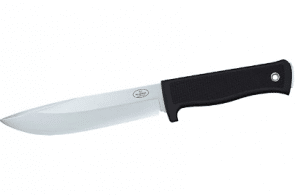
The full-tang blade stretches outright to an exposed pommel, giving the alternative to utilize it as a striking surface. The rubber-treated handle is very grippy, with a slight diamond design. The finger guard is strong and keeps a decent measure of material between your fingers and the blade.
The Zytel cover is straightforward and ensures and makes sure about the blade pleasantly; not to mention, it’s an inflexible sheath, which makes it somewhat less pleasant on the hip or thigh, however it does all around appended to a pack or strap. Sadly, it’s not MOLLE viable.
In any case, similarly, as with any great brand, there are a lot of fakes. Laminated steel blades frequently show faint lines along the honed side, like acclaimed Damascus steel. The fakes, made of lesser quality steel, regularly do not have the fine striations yet are generally indistinguishable. These inferior blades are likely to chipping and lose their edge rapidly. So make sure to purchase things from reliable vendors and examine your knives right away.
Advantages:
- Incredible VG10 laminated steel
- Even and strong design.
Disadvantages:
- A lot of fakes
- High price
Ontario Black Bird SK-5 Knife
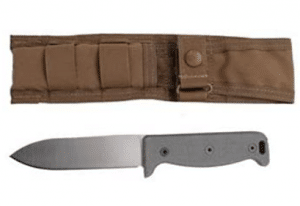
It’s an amusing fair size blade for almost all of the standard camp tasks. It very well may be somewhat little for batoning, yet it cleaves, cuts, and deals with medium kindling easily. The 154 CM stainless steel is perfectly resistant to erosion and is worked to last. It’s tough and holds a fine blade also; obviously, it tends to be difficult to sharpen it.
The synthetic G10 handles are tough and simple to get rid of for cleaning, yet the shape is somewhat blocky and not the most pleasant design. It is possible to re-shape them yourself if you want to set aside the effort to get it great.
The MOLLE viable sheath is well-constructed and attaches well, making it advantageous to keep your knife anyplace you need it.
Advantages:
- Stainless steel is resistant to rust.
- Removable scales allow for cleaning and upkeep of the edge.
- MOLLEE viable sheath
Disadvantages:
- The handle is, to some degree, blocky.
Schrade SCHF9 Extreme Knife
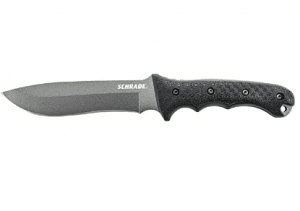
I state “semi” because there is little of the characteristic crook bend of a kukri, yet the drop tip blade has a HUGE bend in the belly, which puts the knife’s focal point of mass more towards the tip.
This makes it a proficient chopping knife for clearing brush, limbing and honing sticks, and parting kindling; besides, the sharp blade is made of high-carbon 1095 steel, an incredible decision for a wide range of blades. It holds an edge very well and can be sharpened effectively. However, it requires ordinary cleaning and support to prevent the process of erosion.
The textured elastomer handle is not really difficult to hold and has positive finger placements to keep the knife solidly in your control. It actually makes it simpler to use the exposed pommel as an improvised nutcracker, pound in stakes, or break the glass.
The ballistic nylon sheath is useful yet slumps around a piece without the leg tie. In this way, I’d lean toward a MOLLE viable cover and would rather think of a reseller’s exchange overhaul.
Advantages:
- Awesome for tough chopping tasks
- Great 1095 steel
- Strong handle design
Disadvantages:
- The cover is awkward in hip attachment configuration.
- The blade needs control to prevent erosion.
What Makes a Survival Knife Good?
Before straightforwardly jumping into all the obtainable choices for knives (for example, blade length, edge, grinds, grips, etc., and so forth), we should feature the greatest survival knife features and peculiarities to pick the IDEAL survival knife.
Here we present you with the best survival choices and products you’ll need in any survival knife you pick:
Fixed blade strictly!
A fixed sharp blade knife is actually what it seems like. The blade’s cutting edge is in a fixed position, which means that it doesn’t switch, flip, or overlay down. The less is the amount of moving parts of the knife. The more sturdy the blade is for long-term use. A robust, well-built fixed edge blade can deal with some callous things. For instance, quite possibly the most abusive survival method for blades is batoning.
Batoning with a knife is a severe test, indeed.
I had a go at batoning with an excellent folding knife once, and it destroyed the springs and clasps inside 5 minutes. Since you need your knife to last while having the option to play out the toughest actions, shop in the “fixed blade survival knife” stock.
Try not to misunderstand me, folder blades are marvelous, and I have a Kershaw Onion folder every day with me; however, they are not reasonable for pure surviving conditions. A fixed blade knife is a thing that you need for endurance. It’s a knife you can stake your life on.
Folder blades have a shortcoming that fixed edges don’t. They have a rotating joint that makes them foldable. Thus when you abuse a folded blade, the joint will simply break.
Knife Size Matters…
Too large, and you’ll be unable up to accomplish detailed cutting work like cutting detailed snare sets or exactness cutting. Excessively little, and you’ll be missing meaningful basic actions like chopping, cutting big things, and batoning. You need a blade knife little enough for accuracy yet sufficiently big to be rough for harder tasks. So, basically, you are looking for the 9 to 11-inch general knife length.
Knife Blade: Drop Tips and Spear Points
Numerous tool designers need to stand apart from the group and plan strangely yet perfectly looking knife blades with crazy shapes. Probably, they look boss or cool, yet they won’t work for you in survival circumstances. Spearpoint or drop points are best for use in self-defense situations. They additionally allow you to perform fine point work.
In this way, except if you’re searching for a blade to garnish your Halloween look in 2021 – stay with the straightforward yet successful sharp blade shapes of both a spear point or a drop point blade, and you will love it.
Full Tang Blade Only
The tang of a blade is the metal area that is enclosed by the blade’s grip. A valid and reliable full tang knife profile fills the whole handle with uncovered metal around the edges. In contrast, a halfway tang blade is the profile where the metal is present in a smaller amount and placed directly inside the handle.
Full Tang knives are meant to face much more use (and probably misuse) than a partial Tang knife. If you hit the part-Tang knife, it will actually weaken and get a play in the handle. In case the grip is broken, it’s extremely troublesome and risky to utilize a partial tang knife – while a full-length blade can be wrapped with approximately 550 paracord and still work pretty great.
There are additionally rat-tail tangs and hidden tangs, and these are even less tough than a part-tang. So preferably, one will need a full tang knife. Still, partial tangs are respectable for survival purposes, too: the main concern is the more metal in the handle, the better-truly, these blades cost somewhat more, yet it’s justified, despite any trouble.
Single Edged Blade
Single-edged knives have just one profile side of the edge sharpened and utilized for cutting, while twofold edges are sharp on the two sides. What’s more, in surviving conditions, the flat side is as meaningful as the sharp side:
- To start with, it helps with cutting control. You’re ready to push your finger safely up onto the flat blade, while this control method is beyond the realm if the edge was sharp.
- Second, when batoning to slice wood, a twofold edge goes against you: you wind up beating down a sharp blade and losing your striking force.
- Third, it’s a lot simpler to utilize fire steel with a flat blade. A level 90-degree grind is excellent for getting sparkles from a fire steel.
The Lower Part of Handle Flat
Search for a tool to utilize the butt of the handle as a DIY hammer for easy tasks. This way, you need the butt of the handle to be not round and flat: this permits you to drive tent stakes into the ground. Also, you can employ your blade as a stroke. Just push the blade by beating the bottom of it with a piece of wood.
What About Knife Designs?
In the following part of the article, we will plunge into all the particular details behind various survival knife designs, the steel differences, the coatings, grinds, tangs, brands, and so forth, and the benefits and drawbacks of each.
In particular, we will cover the list below in detail:
- Blade Design
- Fixed Blade vs. Folding Blade
- Blade Length, Steel, Grind, Coatings
- Tang Construction
- Grips
Blade Design: What is the Right Blade?
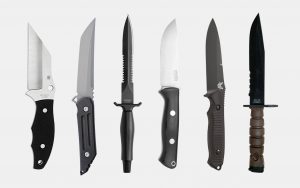
Settling on the blade design shape is perhaps the main component while picking your survival knife; for instance, in a survival circumstance, you’ll probably use each bit of the blade from the belly to the tip for every task possible. So, you might have to know some basic knowledge of all the blade and knife shape choices.
There are four primary choices concerning side knife design (skewer, tonto, clip point, or drop point). As we covered before, for surviving purposes, we suggest you go with a drop point for most endurance knives since these blade designs put the tip of the blade near the centerline of the blade, which gives excellent control. It likewise brings down the weight at the tip of the blade, helping with moving the blade’s balance point closer as far as possible: this helps to give the person more prominent tip control. Nonetheless, it’s great to understand the applications for the other blade designs in every case. You may as of now have your “go-to” survival knife, and you’re in the market for a practice blade.
Here’s a brilliant video of these mane knife design choices
Which One to Choose for Surviving: Fixed Blade Knife VS. Folding
Fixed blade knives are required in brutal survival circumstances. Nonetheless, fixed blade knives are bulkier to carry with yourself all the time: you can’t carry a huge fixed blade knife around the city and be completely okay and unnoticed by strangers on the streets…
So, for ordinary everyday life needs, you should think of the folding blade. They are ideal for everyday use situations when you do not need to make survival houses or making a fire starter in the woods. Yet, for a true survival knife, you need something substantial that won’t break under serious use and misuse as well.
Truly, a decent pocket knife should be in your pocket. However, it additionally should never be your primary survival knife for outrageous circumstances. So, be sure to have some pocket knives for urban endurance, probably.
Edge Length: From Short to Long
The length of a knife’s blade defines how helpful it is for certain tasks. Choppers are your huger machete-like blades, while accuracy bushcraft work (actually bushcraft knives frequently have leather sheath) is best with more petite carver knives.
For survival, you need a touch of both, so the most helpful and suitable for every situation survival blades will, in general, be in the medium area range.
Endurance Blade Steel. What are the Components?
There are various types: high carbon steel (for example, 1095, 5160, or A2) VS. hardened steels (for example, 420HC, 440C, AUS-8, or AUS-10) – as should be obvious, there are a ton of blade steel choices. In laymen’s terms, high carbon device will, in general, be harder than stainless steel, which means they are a lot tougher to break; nonetheless, they are more non-resistant to erosion. They likewise are simpler to sharpen than stainless ones but will not keep an edge very well.
In case that you need to understand the distinction in blade steels, you need to argue like a knife-maker: the video below will show all the different steel choices; besides, it is worth viewing if you need to get an extra presentation of blade steel options.
Blade Grinds: What are the Types?
There are several options for sharpening the blade for any knife design. In short, each grind has its own advantages and disadvantages depending on how the person wants their tactical knife to work.
In any case, for survival purposes, two obvious blades remain above the rest: the saber and the flat grinding. Saber sharpening has a short main angle from the front line to the back of the blade. This makes the thicker edge more difficult to hone to a fine point; however, it will better hold its edge during chopping and bludgeoning. In fact, there is a flat sanding, which is a compromise between saber sanding and hollow sanding. The hollow grinding bends from the inside of the blade to the cutting point, making the blade (cutting edge) very sharp but prone to chipping and damage under extreme use. Then the flat grind has a bevel that goes from the front straight to the back of the blade. This allows for a much better edge than saber grinding, but it is not as brittle as hollow grinding.
If this all sounds a bit confusing (I’m sure it is), check out the videos below to get the perfect overview on the topic of blade grinding.
Handle Material: Best Grips
The grip of a survival knife is basic to its work: you need a handle that is tough and strong and won’t break under exceptional powers; however, it must feel comfortable and great in your grasp. You likewise need a handle that won’t get wet on your hand, resulting in handling rot.
A couple of the most popular blade handle materials are wood, Micarta, G-10, Zytel, Krayton, or Hypalon: the video below goes into a fine start to some of these materials!
Blade Coating Variants
The topic of blade coatings is tough and complex; however, it’s a fascinating science! This video gives you a small review of 6 diverse blade coatings put through a broad system of tests. Make a point to watch as far as possible to discover which blade covering holds up the best.
Knife Grip Techniques
At last, I needed to share a thing about grip methods. I believe it’s as crucial (perhaps more) to put the time in figuring out how to use your new endurance knife. A knife is only a bit of survival gear, and it only makes sense in the hands that hold it right.
So watch the video to get to know to use your survival knife once you decide which one to purchase.
Full-Tang Vs. Partial Tang
We just suggest you go for a full tang survival knife. We discussed it already, so that I won’t go over this once more! However, some future blade lovers might need a presentation into partial tangs (rat-tail tang, narrow tangs, hidden tangs, etc.).
This video below has a cool summary of this contradictory blade topic
Best Survival Knife Summary
Survival knives appear in a wide range of shapes, forms, and designs, as you now know. One should choose for oneself which knife is most appropriate for your needs. The great news is that you should spend money on a few survival knives: for your bug out bag, for your survival pack, one for the medical first aid kit, and for the get home bag.
I don’t know anyone who’s not kidding about the whole survival thing, which owns only one blade. For example, we own loads of various knives we’ve collected throughout the long term, with each knife filling a particular need.
For instance, there is a video by a survival master who presents his assortment of knives for survival conditions.
Keep in mind: Plan, Modify, and Succeed.
Frequently Asked Questions – FAQ
What is the best knife for survival?
We have discussed each sort of them in the previous part. Let’s briefly cover it one more time. Here are the best brands of knives for survival conditions that many customers enjoy (they are of different prices):
- Best in general: Esee 5
- Best on a budget: Morakniv Kansbol
- Best big item: Becker BK9
- Best high-end: Benchmade 162 Bushcrafter. This Bushcraft knife will bring you hard times to hone but has good edge retention.
But of course, each person should, first of all, rely on his or her needs for knife use, and only then choose while buying a knife. There are different blade material elements, e.g., cold steel. There are several categories of sheaths, e.g., leather sheath, there a lot of accessories for knives, e.g., paracord holder.
What is a survival knife used for?
Many survivalists have various kinds of knives, each for a separate purpose, e.g., food prep and hunting, or starting a fire, or emergencies. As a rule, hunting knives are the most popular among survivalists, as they are suitable for the harshest tasks.
Can I carry a survival knife?
In general, yes. Nonetheless, it depends on the size of the knife you plan to keep with you daily. It is more useful in urban surviving conditions to carry a folded knife rather than a full knife because a full knife won’t be unnoticed, and an open sharp blade is certainly not a great thing while exploring the city, for example. So, go for a folded one for everyday use. Multi-tool is also a great choice. It also depends on the country where you live, and here I am speaking about the laws of cold steel. Be aware that knives are not the best choice for self-defense in the urban surviving conditions.
Is the Ka-Bar a good survival knife?
First of all, it is a knife with a big history starting from US Marie in 1942. The KA-BAR survival knife has proven itself in survival and combat situations, work, and service situations. In general, it’s a great survival knife, especially in its price range.


